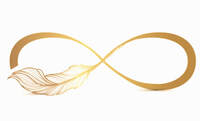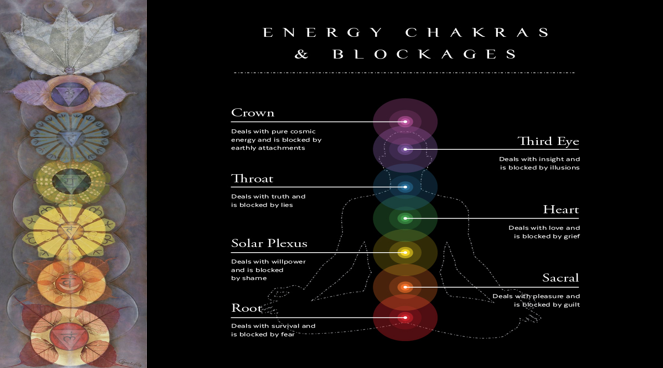|
Our Activating and Expanding your 8 Psychic Centers - 8 Week Workshop is well underway. I have been guided to share the following for deeper self reflection, to assist you along your healing journey. If you are reading this and you have not registered for our workshop and you would like to. You are welcome to click on the link below to join us.
Activating Your 8 Psychic Centers Please, Register so you can access the previous recordings and class content. Infinite Gratitude and so much Love. Namaste Angelique The Chakras Chakras are powerful energy centers that affect our causal, subtle and gross bodies and everything we do. Chakras have a relationship to specific functions of the physical and emotional body. Physically, each center correlates to major nerve ganglia that branch forth from the spinal column. The first five chakras are connected to specific sense organs. They store psycho-physical energy, which then flows to all seven chakras. The breath activates this flow from one chakra to the next. In addition, the chakras also correlate to levels of consciousness, archetypal elements, developmental stages of life, colors, sounds, bodily functions and more. Chakras relate to different energetic sites of the human body, as well as to parts of the endocrine system. Made of prana, the chakras function to take in higher vibrational frequencies from everything around us. They transform each frequency into a form of energy useful to the physical body. Each major chakra vibrates at different rates, and each will absorb energy harmonically related to its own natural frequency. The chakras absorb energy from the environment. The nadis (subtle energy channels) then direct this energy to the organs. Ayurveda considers the chakras a vital part of health, healing and spiritual growth. Chakras are affected by impressions of sound, touch, smell, sight and taste. In numerous healing systems, sound, aromatherapy, crystals and gemstones, color (or light), tuning forks and other vibrational methods are utilized for chakra balancing. Such chakra therapy has become popular in western healing systems. Traditionally, mantras, yantras, yagnas and yoga asanas were also used to harmonize the charkas. Situated along the sushumna nadi (the central nerve channel), the seven chakras relate to different emotions, thoughts, and actions. Each chakra has a specific mantra and relates to one of the senses and organs of action. The chakras are represented by different forms of lotus flowers; each lotus represent an awakened state of consciousness. The word chakra means “wheel.” When all of the chakras are “spinning,” open, bright and clean, our chakra system is balanced. When a chakra becomes blocked, damaged or muddied with residual energy, our physical and emotional health can be affected. Often these disorders occur habitually as the result of negative belief systems. The effects of our habits, feelings, beliefs, thoughts and desires can be found in our chakras. They may be utilized as a pathway for gaining a strong, clear and balanced energy system. An open state of being affords the most efficient flow of energy through the system. This flow of energy is essential for vitality, health and growth on all levels. Ideally, all chakras contribute to the wholeness of our being. This inspires our instincts to work together with our feelings and thoughts to create positive emotional and spiritual balance. All of our senses, perceptions, states of awareness- everything that is possible for us to experience- can be divided into seven categories. Each category can be associated with a particular chakra. In this way, each of the chakras represents not only particular parts of the physical body, but also specific parts of consciousness. Some chakras are not open enough or are underactive; to compensate, others are overactive. The chakras are constantly trying to create a harmonious balance. Muladhara (Root Chakra) The first chakra muladhara, is located at the base of the spine. Mula means “root.” It has four petals and is correlated with the earth element. Its mantra is lam and its color is red. Muladhara is the resting place of Kundaline Shakti, the divine feminine principle. When She awakens, She rises to the sahasrara (crown chakra), the abode of Shiva, the divine masculine. Muladhara chakra correlates to the organs of elimination. It governs our physical existence, our bodies and our health. It rules the nose, sense of smell, the anus and elimination. It corresponds to the sacrum and gives the feeling of being grounded. It relates to our biological needs and comfort. On a psychological level, it relates to fear and ignorance, or maya. In a balanced state, it gives a sense of stability and groundedness, and gives the strength to manifest our visions. Muladhara also relates to survival instincts, safety, connection to our body and the physical plane. Ideally, this chakra brings us health, prosperity, security and dynamic presence. Svadishtana (Sacral Chakra) Located in the abdomen, lower back and sexual organs, just above the root center, the second chakra, svadishtrana, relates to the reproductive organs. Svadishtana means “the abode of the Self.” It has six petals and is of the element water. This chakra’s mantra is vam and its color is orange. It rules the tongue, sense of taste and the reproductive organs. The second chakra relates to emotions and sexuality. It connects us to others through feeling, desire, sensation and movement. In balance, this chakra brings us fluidity and grace, creativity, depth of feeling, sexual fulfillment and the ability to accept change. Manipura (Solar Plexus Chakra) The third chakra, manipura, is located near the navel in the solar plexus. Manipura means “the city of gems.” It has ten petals an rules the element fire. This chakra’s mantra is ram and its color is yellow. Manipura governs the navel center and our digestive organs. It rules the agni, the fire that digest food as well as life experience. Manipura is the seat of the ego and will power. In harmony, it is the power to surrender to will of the Divine. Manipura is the fire of self-discipline. It rules personal power, autonomy and metabolism. When balanced, manipura brings us energy, effectiveness, self-confidence, spontaneity and non-dominating power. Anahata (Heart Chakra) The fourth chakra, anahata, governs the heart. Anahata means “the unstruck sound.” It has twelve petals and rules the air element. Anahata’s mantra is yam and its color is green. This chakra rules the skin, the hands and the sense of touch; it also creates prana. It represents the two polarities of body and spirit as interconnected in perfect balance. When this chakra is in harmony, one feels unconditional love, empathy and devotion. Anahata governs the experience of interconnectedness. Through love, it integrates the opposites in the psyche: mind and body, masculine and feminine, persona and shadow, ego and unity. A healthy fourth chakra allows us to love deeply, feel compassion, and have a deep sense of peace and centerdness. To fully open the heart chakra, we need to bring the various aspects of our existence into balance. Vishuddha (Throat Chakra) The fifth chakra, vishuddha, is located in the throat. Vishuddha means “pure.” It has sixteen petals and is the color blue. Vishuddha rules the throat, ears and mouth and governs sound. Its mantra is ham. An imbalanced vishuddha chakra leads to blockages in communication and expression, as well as repressed feelings. When harmonized, it is a source of inspiration and expression. Vishuddha is related to communication and creativity; furthermore, when activated, we experience the world through vibrations, such as the vibration of sounds representing language. Ajna (Third Eye Chakra) The sixth chakra, ajna, is located behind the pineal gland. It is commonly known as the “third eye.” Ajna means “commanding” or “infinite power.” It has two petals and is the color indigo. Ajna’s mantra is ksham and it governs the mind, giving the power of divine perception to see things as they truly are. Ajna governs the pineal gland. It gives the powers of discrimination, creativity, detachment, inner vision and stillness of the mind. It is related to the act of seeing, both physically and intuitively, and as such it opens our psychic faculties, capacities and our understanding of archetypes. Sahasrara (Crown Chakra) The seventh chakra or crown chakra is called sahasrara. It has one thousand petals and its mantra is aum. Sahasrara is the place of Divine Consciousness and the dissolution of ego. When Shakti awakens, She rises to merge with Shiva, who is the pure consciousness that resides in the sahasrara. The seventh chakra is at the crown of the head, and is violet fading to white as it moves further away from the body. This chakra enables the connection to move our higher selves and to the Divine. It is associated with wisdom and integration of our eternal self with our physical self. The sahasrara is like an umbilical cord to God. When the crown chakra is open and active, we can become a vessel for God to work through. Ultimately, this chakra is our connection to a timeless, spaceless place of all-knowing. When developed, sahasrara brings us knowledge, wisdom, understanding, spiritual connection and bliss. The Chakras and Koshas The chakras are correlated with the Koshas. Muladhara chakra works together with the annamaya kosha for the instinct and purpose of survival. Svadishtana chakra relates to pranamaya kosha in the soul’s process of self-identification and the instinct of procreation, or continuity. The manipurna chakra relates to manomaya kosha, for they work together to achieve goals through the power of ambition and will. Anahata chakra relates to vijnanamaya kosha to achieve the perfect state of love and compassion. One who has attained true wisdom naturally loves all beings as one’s own Self. Vishuddha chakra relates to vijnanamaya kosha and the ability to clearly vocalize the heart’s ambition. Ajna chakra relates to the anandamaya kosha, together dwelling in the stillness of the inward-drawn consciousness. Sahasrara chakra is beyond all the koshas, as it is the Self dwelling within the Self. The Workshop that I facilitate includes Mayan Light Language to assist in opening your 8 Psychic Centers. This class is provided in a group as well a 1:1 coaching service.
0 Comments
“Promise Yourself To be so strong that nothing can disturb your peace of mind. To talk health, happiness, and prosperity to every person you meet. To make all your friends feel that there is something in them To look at the sunny side of everything and make your optimism come true. To think only the best, to work only for the best, and to expect only the best. To be just as enthusiastic about the success of others as you are about your own. To forget the mistakes of the past and press on to the greater achievements of the future. To wear a cheerful countenance at all times and give every living creature you meet a smile. To give so much time to the improvement of yourself that you have no time to criticize others. To be too large for worry, too noble for anger, too strong for fear, and too happy to permit the presence of trouble. To think well of yourself and to proclaim this fact to the world, not in loud words but great deeds. To live in faith that the whole world is on your side so long as you are true to the best that is in you.” ― Christian D. Larson |



 RSS Feed
RSS Feed